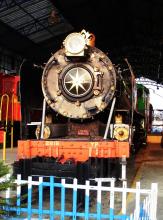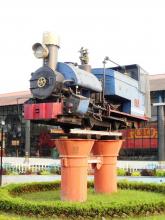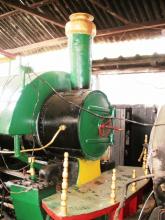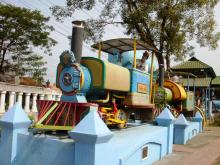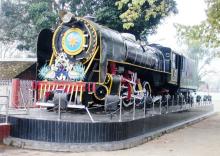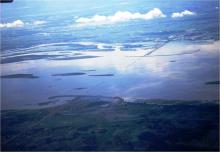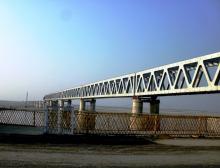Note: This write-up was penned in 2015
The only Margherita that I was aware of was the “Margherita pizza” that I had seen printed on the menus of many of the well-known pizza restaurants. Perhaps I had consumed this pizza as well but I do not recall having done so at the time of penning this write-up. Be that as it may, here I was, standing in front of the Coal Heritage Park and Museum of the North Eastern Coalfields of Coal India Ltd. in the town of Margherita in the easternmost corner of Upper Assam. What could be common between a culinary delight and an out-of-the-way coal town, I wondered? I got my answer when I entered the museum. Both, the town and the pizza, were named in honour of the then Queen of Italy, Margherita Maria Teresa Giovanna. Thus, Sonia Gandhi was not the first Italian lady to have an influence in our country; she was preceded by more than a century by her country’s 19th millennium Queen.
It happened in the year 1884, on February the 18th. On this day, the official opening of the coalfield took place and the township was named Margherita as a tribute to the Italian Chief Engineer, Chevalier Roberto Paganini. It was this Chief Engineer who built not only the first wooden bridge across the nearby Dehing River but also the rail line on both banks of the river. In addition, he founded the settlement around the bridge, that grew to the present town. Thus, it was at Margherita that the coal industry in Upper Assam was born. Today, it is the headquarters of North Eastern Coalfields.
While the whole of Assam lies to the east of our country beyond Bangladesh, the district of Tinsukhia, in which Margherita lies, is the farthest eastern corner of the state. The only part of India that lies even more to the east is a sliver of Arunachal Pradesh that juts between Myanmar (the erstwhile Burma) and Assam. It is here that while we are still in deep slumber in far off New Delhi, the national capital, the rays of the rising sun first hit our country. It takes another 70 to 80 minutes before the solar orb peeps over the horizon in Delhi and even longer for it to cover the entire nation. Surely, for India, the title – Land of the Rising Sun – would be appropriate for the hills and glades, tea estates and collieries, oil wells and refineries, in this part of our geographically spread out nation.
I had occasion to travel to Margherita and the surrounding areas in February 2015. What you see there is amazing; what you experience and the museums you are able to visit are more impressive than you can imagine. And, I am only referring to the wishes of the rail enthusiast and not to those of wild-lifers or birdwatchers, who would be even more amazed and impressed as the former in their areas of interest.
The most impressive sight, by far, was the Meter Gauge (1000 mm) Garratt locomotive that I came across in the small well-laid and well maintained rail museum at Tinsukhia. Set up by one of its erstwhile Divisional Rail Managers, S. Mookerjee, in 2010, the museum has been named “Rail Heritage Park” and is a must visit for not only the steam locomotive enthusiast but any rail lover. The Garratt on display is the only Meter Gauge Garratt locomotive known to exist. Over 27 meters long, this MWGX class locomotive weighed an impressive 104.24 tonnes when loaded. On its 4-8-2+2-8-4 wheel arrangement, it could reach speeds of 50 kmph and haul a load of 300 tonnes. Built in 1945 by M/s Beyer Peacock Company Ltd. of Machester, UK, for use during the Second World War in Myanmar by the British War Department, at the end of the war it was transferred to the Assam Bengal Railway which later became the North East Frontier Railway, one of the zones of the Indian Railways. The loco hauled trains on the Badarpur-Lumbding Section of the railway before it was retired in December 1975. It was re-numbered a few times and at the time of its condemnation, it bore the number 32086 MWGX.
Also visible next to the Garratt is a water column. Such columns were used for watering of the steam locomotives and were a common sight in the old steam days. Today’s railwaymen will have difficulty recognising one.
Another prominently displayed locomotive at the park is the B-class No. 781. This is one of the oldest locomotives of the Darjeeling Himalayan Railway and had been sold to the North Eastern Coal Fields in 1969. By the beginning of this century, it had become unserviceable. Thus, when NF Railway set up this heritage park, it was gifted back to the railway on the latter’s request.
There are other B class locos on display at various locations. For example, there is one in the National Rail Museum and another outside Rail Bhawan, the seat of the Ministry of Railways, both in New Delhi. The uniqueness of this loco is its presentation. It has been placed atop a bridge pillar in the middle of a well-manicured lawn. The pillar itself is part of NF Railway heritage as it was one of the pillars of Meter Gauge railway bridge No. 556 between Naharkatia and Namrup stations. This bridge had been built around 1898 and just missed a century of life when the line was converted from Meter Gauge to Broad Gauge (1676 mm) in 1997. The designers of the Rail Heritage Park were able to salvage this pillar and use it to display Loco No. B 781.
A third steam loco is on display in the Park. This is loco No. YP 2618, kept in a separate shed along with diesel loco 6114 YDM4. The YP loco, of 1957 vintage, had been built by Tata Engineering and Locomotive Company Ltd. (TELCO). In its heydays, it worked all the important trains of the NF Railway including the Kamrup Express, Assam Mail and Tinsukhia Mail. The conversion of major sections of the railway to Broad Gauge and the ongoing dieselisation and electrification spelt its death knell and it was retired from service in January 1997 after working its last train, 252 DN ex Ledo to Tinsukhia. With a 4-6-2 wheel arrangement, the YPs were the counterpart of the WPs of Broad Gauge.
Diesel locomotive 6114 YDM4 was commissioned in the 1960s and continued to work till 2007 primarily on the Lumbding-Badarpur section. Apart from age, it was retired owing to most of the sections it worked on being converted to Broad Gauge. The YDM4 series of locomotives were the mainstay of the Meter Gauge sections of the Indian Railways till the policy of uni-gauge put an end to its predominance.
It is not that the only items on display at the Heritage Park are locomotives. There is an indoors gallery with interesting exhibits ranging from vintage uniforms to old photographs. Outdoors, you will see a 1892-built Cowan Sheldon’s Narrow Gauge turn-table. On the turn-table is placed a a Narrow Gauge coach SCZ 148.
If the sun was a steam enthusiast, it would be most pleased to be greeted by the sight of an array of steam locos as it peeped over the horizon in this land of the rising sun. Apart from the three locomotives at the Rail Heritage Park, there are other steam locos in the area to greet the rising sun. Next stop for the steams – the Coal Heritage Park and Museum at Margherita.
As you enter the Museum located right in front of the Margherita railway station, you see a string of three steam locomotives on your left. Painted in various hues of green, yellow, blue and pink, they certainly do not appear to have their original colours but are definitely very pleasing to see now. They are neatly displayed and even have mannequins posing as drivers. Named Hassang, John and Shelley, they had been built by WG Bagnall Ltd. of Stafford, England in 1897, 1924 and 1930 respectively. All three have saddle-top water tanks and a 0-2-0 wheel arrangement to run on a 2-foot gauge.
A visit to the Tipong coal field, not far from Margherita, I found a fourth example of the same WG Bagnall-built locomotives. This one has been named David and is again well-kept and preserved. In the same shed was also a B class loco, No. 796. One of the staff of the colliery who was present at the shed claimed that both these locomotives were in working condition. David was too well painted and clean to have worked recently, although it could well be in working condition. The B class locomotive, although not as spic and span as the Bagnall, did give the impression that it could possibly have worked in the not too distant past. However, I am giving the benefit of doubt to the colliery and assuming that the locomotives are in working order, although they did not appear to have been steamed in recent months. There was one SAN diesel as well and in all likelihood bulk of the work is done by it and these locos used occasionally as and when required. I learnt later that there is one more B class locomotive with the Tipong colliery, but I did not see it nor was it mentioned to me by the staff present.
These are not the only vintage locomotives one gets to see in the land of the rising sun. There is one more on display outside Mariani station on the Jorhat-Dibrugarh line. This is a YG 3213. Built by TELCO in 1960, it worked extensively on the Lumbding and Tinsukhia Divisions of NF Railway before it was retired in February 1997. YG locomotives were the counterparts of the YPs for working goods trains. As a result they had a 2-8-2 wheel arrangement, like the WGs of Broad Gauge, with smaller diameter driving wheels than the YP, which had a 4-6-2 wheel arrangement. Till diesels and conversion to BG swept the steams before them, the YG was the main goods locomotive of the Meter Gauge system of the Indian Railways. Smaller and lighter locos were used only where the track or the bridges could not sustain the size and weight of the YG.
Even after this impressive display of steam locomotives of bygone eras, the land of the rising sun has more surprises up its sleeve. One of the surprises that came my way was at the Digboi Centenary Museum at Digboi. This is a museum of India’s pioneering Oil Company and its main exhibit is the first oil well of the country. The well has been kept in its original state. However, in one of the disused alleys at the rear of the museum, I noticed what looked like a steam locomotive and closer examination showed that it was indeed a steam locomotive. It appeared to be one of the WG Bagnall locomotives that were on display at the Margherita museum but this one had no markings of any kind although I looked at it from every possible direction. It was the same size as the Bagnalls with the same wheel arrangement and saddle-top water tank. The length of the chimney and some of the other fittings also corresponded. There was a diesel also lying just behind it, but fortunately this one had its manufacturer’s plate intact announcing that it had been built by Robert Hudson of Leeds, England. The staff at the museum could not give me any details of either the steam or the diesel locomotive. There was an open wagon and some coaches also on this 2-foot gauge disused line. The only information that I was able to extract was that the steam locomotive used to carry trains of crude oil to the Margherita refinery between 1891 and 1901. The Margherita refinery was closed in the latter year. For the record, there are four refineries working in Assam now, located at Guwahati, Digboi, Bongaigaon and Numaligarh.
While moving around the land of the rising sun, the river Brahmaputra is the one feature which is always not too far away. It effectively divides the state into two parts – North and South of the river. When a train line was first laid in this part of the country, there was no rail bridge resulting in the need for a ferry service that took passengers from the trains to Guwahati from the Northern bank. The railways ran this ferry service as they did at a number of other locations in the country. There are now two road-cum-rail bridges across the Brahmaputra, one at Guwahati and the second at Jogighopa, obviating the need for any kind of ferrying. There is a third bridge, albeit a road bridge only, near Tezpur.
A fourth bridge across the Brahmaputra is now under construction at Bhogibheel near Dibrugarh. When completed, its 4.94 kms. length will make it the longest road-cum-rail bridge in the country and the longest bridge of any kind over the Brahmaputra. The bridge is likely to be ready by 2018. A feature of this bridge is that the superstructure is all welded with no use of rivets or fasteners of any kind. This is going to be the first bridge of this kind on the Indian Railways. Constructed by Gammon, the 142 piers that make up the bridge are now ready. The superstructure is being constructed by a consortium of the Hindustan Construction Company, DSD Brouckenbau GmbH, Germany and VNR Infrastructures. Accompanying this article is an earlier aerial view of the bridge when the piers were under construction, and another photograph taken in February 2015 showing the steel work in progress. In the former, you can just about see the piers but the river training works are easily discernible and appear complete.
I strongly recommend that all rail enthusiasts visit the Land of the Rising Sun to not only see the rail heritage that has been preserved but also its tea gardens, animal and bird life, oil and coal fields, etc. The birdlife, in particular, is amazing, there being many birds that you will not see anywhere else in the country. This is also the area where you will find relics of the 2nd World War, such as the cemetery near Jairampur in Arunachal Pradesh, only a few kilometres beyond Margherita. You may also be able to see remnants of the famous Stilwell road from Ledo across the present Myanmar into China. This is a reminder to those who came in late of how close the Japanese came to our country during the War. Last but not the least, there is the powerful and massive Brahmaputra, certainly India’s mightiest river, that makes our other rivers appear to be mere drains or narrow streams. I assure you that your journey will not be in vain.

